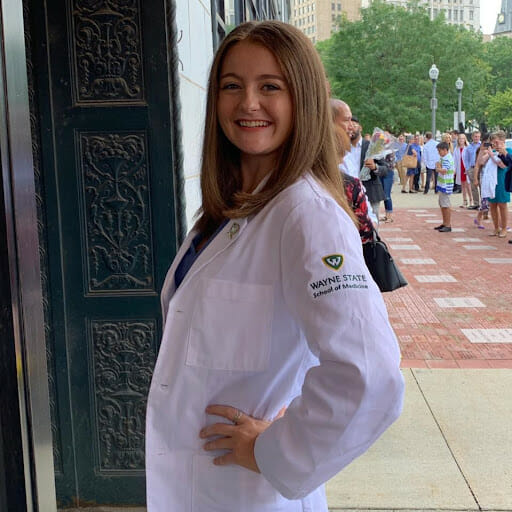I worked as a medical scribe prior to starting medical school, and it was the most valuable experience I could have had in preparation for the medical school curriculum.
What Is a Medical Scribe?
A medical scribe is a healthcare employee who creates a note in the EMR for each patient visit, under the supervision and instruction of the healthcare provider (e.g., MD, DO, PA, NP). As healthcare providers have many tasks on their plate, including seeing patients, developing treatment plans, communicating with patients and their families, writing patient notes, etc., medical scribes are valuable members of the team that help decrease the burden of documentation on healthcare providers. This allows the provider to focus on patient care, and the medical scribe to get valuable clinical experience. They can work in various clinical settings, such as outpatient primary or specialty care, in the emergency department, and even on inpatient wards. Medical scribes are often hired on a part-time basis, as their employers know that most individuals seeking this work are in college and bound for graduate school.
What Does a Medical Scribe Do?
Medical scribes partner with physicians and other healthcare providers to produce high-quality notes in the EMR, with the goal of maximizing efficiency and ensuring appropriate reimbursement for each patient visit. There are a few modalities in which medical scribes can work alongside physicians to assist with documentation. Traditionally, scribes accompany physicians in person during each patient visit. In recent years, with the rising popularity and feasibility of work from home positions, some scribe positions are being offered remotely— either synchronously or asynchronously. The scribe may be present in the room virtually and directly observe the patient visit that way. They might also receive a recording or transcription of the patient visit, and be asked to translate that material into a patient note. Regardless of the logistics, while the physician and the patient interact, the medical scribe documents the following portions of the patient chart:
Chief complaint (CC)
The chief complaint is the reason for the patient’s visit to the physician. This is often a symptom that they find concerning, or follow-up for a chronic disease. For example, a patient may present for evaluation of a runny nose or chest pain, or for a hypertension follow-up.
History of present illness (HPI)
The history of present illness is a narrative description of the patient’s chief complaint, including components such as onset, timing, provoking/alleviating factors, quality (e.g., sharp, shooting, stabbing, or aching pain), and other associated symptoms and context. This portion of the chart is usually not directly dictated to the medical scribe — it is their job to summarize the pertinent positive and negative tidbits from the conversation between the patient and physician.
Review of systems (ROS)
The review of systems is a list of symptoms, by organ system, that a patient is or is not experiencing. Every symptom mentioned in the HPI should be documented in the ROS. There may also be symptoms that are in the ROS, but not elaborated upon in the HPI. For example, the pulmonary section might say “Positive for cough. Negative for shortness of breath, productive cough, and wheezing.”
Physical examination (PE)
The physical examination is a section to describe the physician’s objective findings while examining the patient. Based on the physician’s preference, they may dictate the physical exam findings aloud as they perform the exam, or relay their findings to the medical scribe once the patient encounter is completed. The medical scribe then documents each finding in the note, under the appropriate organ system.
Assessment and plan (A&P)
The assessment and plan includes the patient’s diagnoses and instructions such as the labs and imaging to be obtained, medication to take, and appointments to schedule. The physician will communicate with the patient about their treatment plan, while the medical scribe documents these items and later confirms their accuracy with the physician.
Studying medicine has never been easier.
Set yourself up for success with Lecturio.
How to Become a Medical Scribe
There are many medical scribe companies in the U.S. that have contracts with major hospital systems and hire and train their own employees (e.g., ScribeAmerica, ProScribe, Helix). There are also private practice offices that hire scribes independently. A search on Google or Indeed.com is sure to return many local and remote scribe opportunities, in a variety of settings and specialties. Once you apply for the medical scribe jobs that fit your interests and schedule, be sure to be professional in your communication with the recruiter. Once you shine in your interview, you will receive a job offer, usually somewhere in the $10–$15/hour range. If you are working for a medical scribe company, they will likely offer formal, paid training in using the EMR, note writing, and medical terminology.
New hires usually undergo some form of assessment, usually submitting a few sample notes, for specific feedback. Then, you will start working on notes alongside a medical scribe trainer, often a well-seasoned scribe with tips for success. Once training is complete, you are ready to work independently as a medical scribe!
Why Medical Scribes Become Successful Medical Students
1. Career insight
Medical scribes become very familiar with medical terminology and the workflow of a physician in their chosen specialty. While working in this position, you will become acquainted with the day-to-day responsibilities of a physician, which can help guide your decision making about your career path. If working as a medical scribe confirms your desire to pursue a career in medicine, the experience will be invaluable. Scribes often work longitudinally with the same handful of physicians, which they get to know well.
Most physicians are incredibly grateful for the opportunity to work with scribes, and have the burden of documentation eased quite significantly.
2. Working closely with physicians
Medical scribes develop close working relationships with the physicians with whom they work. This can lead to informal mentorship, career advice, and even endorsement for your next step in your career.
Many medical scribes earn letters of recommendation to be used for applications to graduate school in a healthcare profession.
3. Preview of medical school material
Starting medical school with a working knowledge of medical terminology and note writing will provide a solid foundation on which to build your clinical knowledge.
When it was time to write my first note after a simulated patient encounter in my clinical skills class, I felt confident and was spared the anxiety that many of my classmates experienced.
4. Valuable, paid experience
Many extracurriculars occur on a membership or volunteer basis, AKA unpaid. As a pre-medical student, you very likely have a lot on your plate and your time is valuable!
The experience you get as a medical scribe is unparalleled by your other options for resume builders (e.g., hospital volunteering, student organization membership and leadership), and you get to make some cash while you’re at it. As a former scribe and current fourth year medical student, I highly encourage you to consider working as a medical scribe before medical school.




